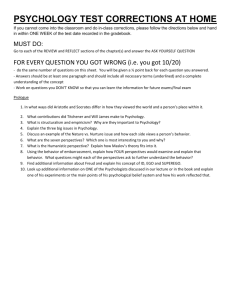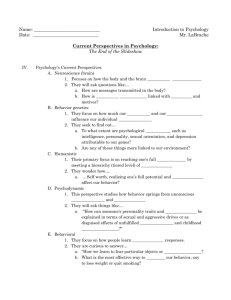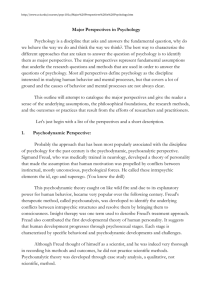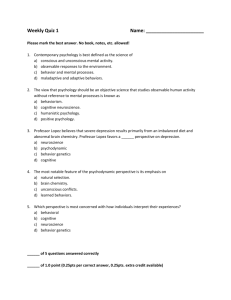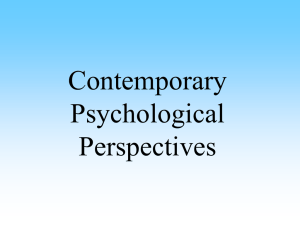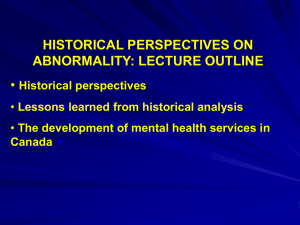INTRODUCTION TO PSYCHOLOGY
advertisement
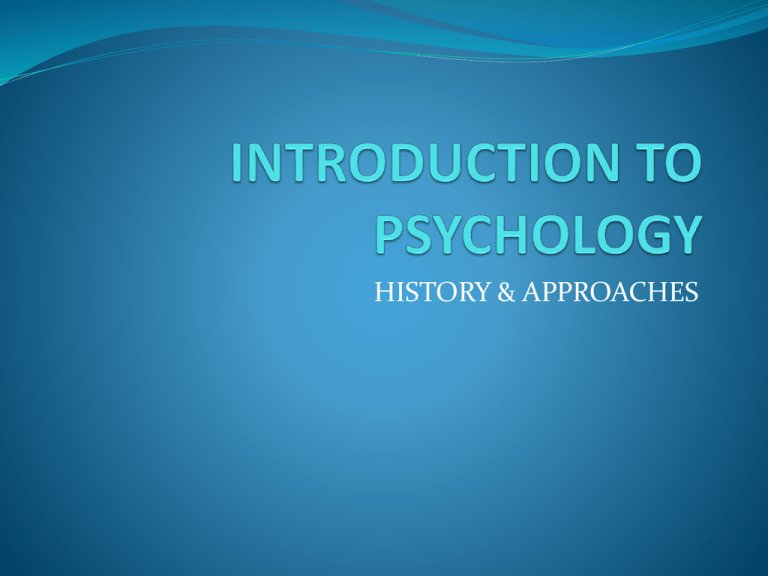
HISTORY & APPROACHES Trace the historical and philosophical development of psychology as a science Psychology has its roots in philosophy and biology. Early “practitioners” were physicians or had background in medicine/biology, particularly neurology. Examples: Freud, Pavlov, Wundt Historic figures Wilhelm Wundt: 1st psychology lab, Germany G. Stanley Hall: 1st psych lab in U.S. @ Johns Hopkins Structuralism: desire to understand the structures of the mind William James: 1st psychology textbook, psychology teacher, U.S., supporter of the “functionalism” concept that the mind adapts and evolves to function in ways that are best for the survival of the being. BIOLOGICAL PERSPECTIVE Describe how the different perspectives explore and explain human behavior. Biological (neuroscience): focus is the role of the brain, neurons, and electrical impulses that result in the creation of memories, process of learning, emotional expression, psychological disorders… The experience of “love” is due to surges in hormones and nervous impulses. EVOLUTIONARY Describe how the different perspectives explore and explain human behavior. Evolutionary: though closely linked to the biological perspective, the focus is on how people have evolved over time in terms of physiology and result psychology. People experience “love” because it is necessary for man and woman to mate in order to propagate the species. This joining has been labeled “love.” PSYCHOANALYTICAL (PSYCHODYNAMIC) Describe how the different perspectives explore and explain human behavior. Psychodynamic perspective: early theories of psychology pioneered by Sigmund Freud explained behaviors stemming form the unconscious (thoughts/experience in which we are not aware). Within the unconscious we are driven to meet very basic animalistic needs of sex and aggression that are suppressed by our conscious thoughts. Freud would have explained “love” as a label for our unconscious drive for sex. BEHAVIORISM Describe how the different perspectives explore and explain human behavior. Behavioral perspective: those who approach psychology from this perspective are concerned with visible behaviors, actions, responses. Pioneer behaviorist is Pavlov and his drooling dogs. A behaviorist may explain “love” as a action response to someone’s attention (gift giving, attention showering, etc.) COGNITIVE Describe how the different perspectives explore and explain human behavior. Cognitive perspective: the focus is on cognitive process such as problem solving, encoding memories, processing information, storage and retrieval, etc. A cognitive psychologist would be most concerned with the information that was processed and how this lead to feelings of “love.” HUMANISM Describe how the different perspectives explore and explain human behavior. Humanistic: the focus is the internal drive and motivations of the individual in terms of their self perception, self concept, and self esteem. A humanist would be interested in a person’s own self love and their development of loving relationships stemming from that. SOCIO-CULTURAL Describe how the different perspectives explore and explain human behavior. Socio-cultural perspective is more of a sociological perspective in that the focus is on the impact the culture and the society has on an individual. They would be most interested in explaining “love” in terms of how it is expressed and learned in a particular culture, family, society…
